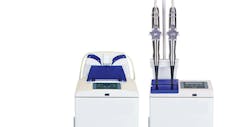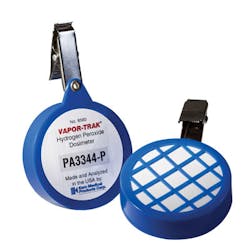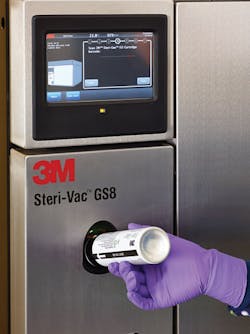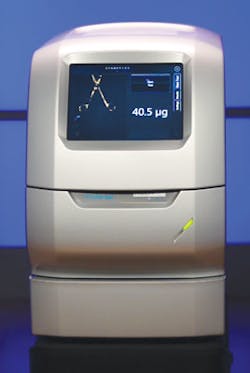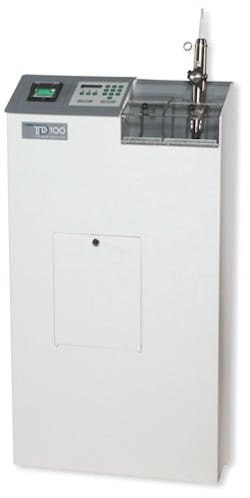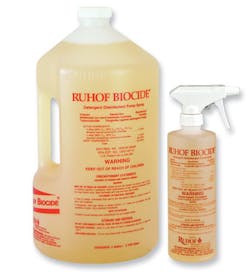It seems like every few months another story on “dirty” surgical instruments hits the media and causes shockwaves throughout the industry. These news reports call attention to what those in the central sterile/sterile processing department (CS/SPD) have long known — that their jobs are critical to delivering safe and effective patient care.
There are a wide variety of sterilants and disinfectants on the market today designed to kill dangerous microbes that can cause hospital-acquired infections (HAIs). For this month’s article, HPN reached out to CS/SPD professionals and manufacturers of sterilants and disinfectants to report on some of the latest trends in this area.
Where do you start?
Formaldehyde, glutaraldehyde, ortho-phthalaldehyde (OPA), hydrogen peroxide, peracetic acid, a hydrogen peroxide/peracetic acid combination, hypochlorous acid (HOCL), ethylene oxide (EtO or EO) — it’s a challenge to keep up with the chemical weapons at a hospital’s disposal to disinfect and sterilize surgical instruments. Matthew Strunk CRCST, CIS, CHL, Business Development Manager at ReadySet Surgical, offers the following advice:
“When selecting sterilants/disinfectants for your facility you should consider both the intended area(s) of use, as well as a product’s ability to be integrated efficiently into your current workflow,” said Strunk.
As industry leaders have begun to pay more attention to process efficiency in CS departments, it makes sense to evaluate products based on how they can be implemented into your current process.
“As thousands of items pass through CS departments daily, technicians are under the pressure to not only process these items correctly but also do so in a timely manner,” he added. “Having the right products in place to complete these vital tasks properly and efficiently is certainly a step in the right direction.”
Staff safety
Because sterilants/disinfectants are designed to kill, staff safety is a major concern. These products can cause a variety of health issues — from throat and lung irritation to cancer. The National Institute for Occupational Safety and Health (NIOSH) has a variety of resources on its website related to the dangers of working with chemical disinfectants and sterilants, including specific recommendations when working with glutaraldehyde, formaldehyde and ethylene oxide (EtO or EO).1
“In every modern healthcare institution, employees face the risk of exposure to toxic chemicals on a daily basis,” said Douglas A. Kruger, President of Kem Medical Products. “As new high level disinfectants (HLDs) and liquid chemical sterilants (LCSs) have been developed over the years, they have often been marketed as a panacea, with promises of being safe substances that do not require the stringent safety and monitoring precautions of their predecessors. This has lead to a false sense of security.”
Kruger says monitoring and measuring employee exposure to chemicals in the healthcare industry is necessary in order to maintain a safe work environment. He also notes that in many cases, it is necessary to demonstrate regulatory compliance. For example, the Occupational Safety and Health Administration (OSHA) Permissible Exposure Limit (PEL) for Hydrogen Peroxide is 1.0 ppm over an eight hour Time Weighted Average (TWA).
Kem Medical Products’ Vapor-Trak Hydrogen Peroxide Monitor measures workplace exposure to hydrogen peroxide. The small, lightweight badge is conveniently affixed on the collar, in the breathing zone. It has the unique ability to move with the employee(s) throughout their entire shift, thereby representing a highly individualized and accurate account of an employee’s personal exposure history. The sophistication of the passive dosimeter technology provides the ability to collect, stabilize and precisely measure levels of chemical exposure. According to the company, it is the most cost efficient method to accurately determine chemical exposure levels.
Addressing endoscopes
Patient injuries and deaths from endoscopes contaminated with carbapenem-resistant Enterobacteriaceae (CRE) have prompted the healthcare industry to reevaluate how it cleans, disinfects and sterilizes these medical devices.
“High-profile CRE outbreaks have raised the urgency to revisit standards and guidelines for endoscope reprocessing,” said Janet Prust, Director, Standards and Global Business Development, 3M Infection Prevention Division. “It also makes sense to reexamine some basic assumptions. For instance, originally, flexible endoscopes were used exclusively for visualization inside the human body (diagnostic endoscopy). Over time, flexible endoscopes with channels for tools enabled ‘therapeutic endoscopy’ and more invasive procedures.”
Prust asks: “Why is this so important? Per Spaulding’s classification, critical devices are those that contact sterile areas of the body or blood, and that ‘Critical items confer a high risk for infection if they are contaminated with any microorganism.’3 Should these endoscopes be sterile? Some would argue that only the tool itself needs to be sterile. However, when a sterile tool is guided through a nonsterile endoscope channel, is that tool still sterile?”
Prust urges each CS/SPD to identify all locations within the facility or system where instruments are reprocessed, noting how there are often satellite locations, such as an endoscopy suite, where additional reprocessing takes place. “As the subject matter experts for cleaning, disinfection, sterilizations and the related standards of practice, CS/SPD managers should provide guidance and oversight to all instrument reprocessing activities,” she said.
According to Prust, several of the facilities affected by the recent high-profile CRE outbreaks adding Ethylene Oxide (EtO or EO) sterilization to their endoscope reprocessing protocols. She cites a variety of studies that demonstrate the effectiveness of EtO/EO against CRE.4-7
“Terminal sterilization with ethylene oxide is a validated reprocessing method described in the IFUs for many models of flexible endoscopes, including high-risk duodenoscopes and other models with elevator mechanisms, and there are no restrictions on the length or inner diameter of endoscope channels,” she added.
The 3M Steri-Vac Sterilizer/Aerator GS series, uses 100 percent ethylene oxide (EO) in single-dose cartridges to safely, effectively, and economically sterilize heat- and moisture-sensitive equipment. Within the sterilization chamber, ethylene oxide is converted to a highly penetrating gas to reliably sterilize complex instrumentation, such as flexible endoscopes. Engineered for operator safety, the 3M Steri-Gas Cartridges are punctured only when the chamber door is sealed and the proper vacuum has been drawn, ensuring that gas remains safely inside the chamber.
“Manufacturers count on EO, too; in fact, over half of all sterile, single-use devices are sterilized with ethylene oxide,” said Prust.
The problem of prions
Proteinaceous infectious particles, commonly known as “prions” are pathogens that are composed of ‘unfolded’ proteins containing no DNA. Creutzfeldt-Jakob disease (CJD) and even evidence that suggests Alzheimer’s disease are examples of transmissible spongiform encephalopathies (TSE) which progress rapidly in the brain and are always fatal making them a major concern to healthcare professionals.8
In their research paper entitled: Reprocessing of Instrumentation Exposed to Creutzfeldt-Jakob Disease (CJD)/TSEs, the International Association of Central Service Materiel Management (IAHCSMM) and the Massachusetts Chapter for Central Service Professionals (MCCSP) explain how “processing surgical instrumentation that may have come in contact with prions requires unique processing guidance.”9 The report states:
“The reprocessing of contaminated instruments that may have been exposed to CJD/TSE in healthcare facilities today need to be assessed. Due to the resilience of prions and potential of the unknown possibility that a patient may have CJD, instrument reprocessing becomes more challenging.”
Investigators at the U.S. National Institute of Allergy and Infectious Diseases (NIAID) Rocky Mountain Laboratories, in collaboration with researchers at the University of Washington (UW) Bothell, UW Seattle and the University of Verona (Italy), recently demonstrated the effectiveness of Briotech’s patent- pending unique proprietary formula hypochlorous acid (HOCL) in inactivating prions.10 HOCL is naturally produced in the body’s cells to aid in ridding it of microbes. Washington-based Briotech has developed BrioHOCl, a proprietary disinfectant comprised of HOCL, for use in consumer and professional healthcare settings.
“This is very significant headway in helping to control this always-fatal disease. Additionally the reagent is mildly acidic and thus reasonably safe to use,” said Jeff Williams, PhD, BVSc., Chief Scientific Officer at Briotech stated, “We believe we’ve just exposed the tip of the iceberg when it comes to revealing the full potential of the pure HOCl in controlling and preventing many transmissible diseases.”
“Through a series of highly involved scientific studies, the results clearly indicate the great success of inactivating prions among other infectious agents over currently available approaches including bleach,” said Thomas Overbey, Director of Marketing for Ultra Clean Systems.
“The ProReveal is a device that detects residual protein on surgical instruments even after they have been sterilized,” said Overbey. “So what this means is if facilities monitor and keep their residual proteins at or as close to zero as possible, then that may help reduce HAIs and the possible threat of prion disease, since in fact prions are proteins. The ProReveal also helps Sterile Processing Departments to benchmark themselves and provide a good cleaning verification system as indicated by AAMI.”
A probing question
In its Guidelines for Cleaning and Preparing External- and Internal-Use Ultrasound Probes Between Patients, the American Institute of Ultrasound in Medicine (AIUM) states: “All internal probes (e.g., vaginal, rectal and transesophageal probes), as well as intraoperative probes, require high-level disinfection before they can be used on another patient.”10
Disinfecting larger ultrasound probes can be challenging to healthcare facilities. The ASTRA VR automated reprocessor from CIVCO Medical Solutions can disinfect probes up to 16 inches long. ASTRA VR allows healthcare facilities to disinfect one or two probes at a time, at different depths. It features low operating costs and fully automated logging, with a barcode scanner and automatic tracking of consumables. ASTRA VR automatically captures probe ID, operator ID, exam ID, MRC results, temperature, cycle outcome, date and time, and consumables. All disinfection data from the last 2,000-plus cycles are stored in the ASTRA VR, resulting in a completely automated disinfection log, which can be downloaded as needed. CIVCO Medical Solutions also offers the ASTRA TEE for reprocessing transesophageal probes.
For automated HLD Tee ultrasound probe disinfection, the TD 100 Automated Tee probe disinfector from CS Medical does the job in five minutes with single-use TD-5 high-level disinfectant. It also offers five individual rinse cycles, disinfection verification with printed reports, diagnostic checks and safety features to help keep staff protected and productive. A microprocessor-controlled system makes it easier for medical personnel to use and the built-in advanced vapor management feature captures and neutralizes fumes.
Keeping the environment clean
In order for the CS/SPD to produce sterilized instruments — and the operating room to maintain instrument sterility — they both need clean environments. In its “Environmental Cleaning Tool Kit – Cleaning in Sterile Processing Areas Module4,” the Association of periOperative Registered Nurses (AORN) states: “Terminal cleaning and disinfection of sterile processing areas should be performed daily when the area is used.”2
The Ruhof Biocide Detergent Disinfectant Pump Spray is a ready-to-use quaternary germicide cleaner and disinfectant for use in patient rooms, operating rooms, intensive care unit (ICU) areas, public restrooms or any other area that needs to be disinfected. It is formulated to be highly effective against a broad-spectrum of pathogenic microorganisms, including bacteria, antibiotic resistant bacteria, viruses, fungi, mold and mildew.
The Ruhof Biocide Detergent Disinfectant Pump Spray is for use on all hard, non-porous inanimate environmental surfaces: floors, walls, metal surfaces, stainless steel surfaces, bathrooms, shower stalls, bathtubs, cabinets, etc. In addition, this product deodorizes smelly areas such as garbage storage areas, empty garbage bins and cans, basements, restrooms and other places that are prone to odors caused by microorganisms.
References
1. http://www.cdc.gov/niosh/topics/repro/disinfectants.html
2. http://www.aorn.org/guidelines/clinical-resources/tool-kits/environmental-cleaning-tool-kit
3. CDC Guideline for Disinfection and Sterilization in Healthcare Facilities, 2008 William A. Rutala, Ph.D., M.P.H. David J. Weber, M.D., M.P.H., and the Healthcare Infection Control Practices Advisory Committee (HICPAC).
4. Epstein L, Hunter JC, Arwady MA, et al. New Delhi Metallo-β-Lactamase—Producing Carbapenem-Resistant Escherichia coli Associated with Exposure to Duodenoscopes. JAMA. 2014;312(14):1447-1455. doi:10.1001/jama.2014.12720.
5. McCool S, Muto CA, Querry A, et al. High Level Disinfection (HLD) Failure in Gastrointestinal Scopes with Elevator Channels — Is it Time to Switch to Ethylene Oxide (ETO) Sterilization? Poster presented at: IDWeek; October 8-12, 2014; Philadelphia, PA.
6. UCLA statement on notification of patients regarding endoscopic procedures. UCLA Health Website. https://www.uclahealth.org/news/ucla-statement-on-notification-of-patients-regarding-endoscopic-procedures Updated February 19, 2015. Accessed August 25, 2015.
7. Smith ZL, Oh YS, Saeian K, et al. Transmission of carbapenem-resistant Enterobacteriaceae during ERCP: time to revisit the current reprocessing guidelines. Gastrointestinal Endoscopy. 2014;81(4):1041-1045. doi:10.1016/j.gie.2014.11.006.
8. http://www.aium.org/officialStatements/57
9. https://www.iahcsmm.org/images/Resources/IAHCSMM_MCCSP_ResearchPaper.pdf
CS PRODUCT SPOTLIGHTS
Automated Ultrasound Probe Reprocessing
The ASTRA series of automated reprocessors from CIVCO Medical Solutions allows healthcare facilities to disinfect one or two ultrasound probes at a time. ASTRA automatically captures probe ID, operator ID, exam ID, MRC results, temperature, cycle outcome, date and time, and consumables, resulting in fully automated disinfection logging.
Vapor-Trak Hydrogen Peroxide Monitors provide a convenient, cost effective, and accurate way to measure personal and area exposure levels of hydrogen peroxide. All monitors include postage paid mailers, prompt laboratory analysis, and detailed lab reports that serve as documentation of regulatory compliance (OSHA PEL of 1.0 ppm/8 hour TWA).
About the Author
Kara Nadeau
Senior Contributing Editor
Kara Nadeau is Sterile Processing Editor for Healthcare Purchasing News.
